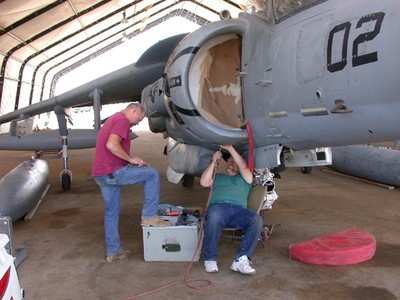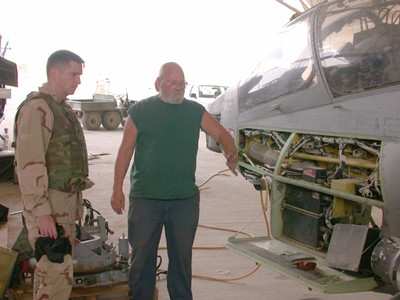 Aircraft
“ready-for-tasking” is a term used to describe military
aircraft that are sitting on the tarmac, mission-capable and ready
for continual combat operations. It is also a vital metric used by
the Navy to measure readiness.
Aircraft
“ready-for-tasking” is a term used to describe military
aircraft that are sitting on the tarmac, mission-capable and ready
for continual combat operations. It is also a vital metric used by
the Navy to measure readiness.
Sustaining those aircraft is the job of the engineers and
artisans at the three NAVAIR depots (NAVAIR Depot Cherry Point,
N.C., NAVAIR Depot Jacksonville, Fl. and NAVAIR Depot North Island,
Calif.), and the two overseas depot repair activities in Naples,
Italy and Atsugi, Japan. Both the Naval Air Mediterranean Repair
Activity (NAMRA) and the Naval Air Pacific Repair Activity (NAPRA)
perform scheduled and unscheduled depot-level aircraft maintenance
and in-service support, and provide field teams afloat to maintain
deployed Carrier Strike Groups in the Western Pacific/Indian Oceans
and Mediterranean/Europe/Navy Central Command areas of
operation.
NAMRA is the NAVAIR command responsible for coordinating
depot-level structural repairs to aircraft operating ashore in the
Central Command area of operation. And nowhere in the world is it
more important to have aircraft ready-for-tasking right now than in
Iraq.

“The more aircraft we have on the line ready to fight
allows us the capability and flexibility to multi-task in support
of the warrior in the dirt and keep the insurgency guessing where
we’ll be next,” said LtCol Don Fincham, 2nd Marine Air
Wing (MAW) Aircraft Maintenance Officer at Main Operating Base Al
Asad, Iraq.
“Responsive evaluations and expedient repair turnaround
times ensure we retain mission ready aircraft on the Al Asad flight
line to fight this war,” Fincham added.
Early in 2004, in coordination with the 3rd MAW and NAVAIR Depot
Cherry Point, NAMRA placed a five-man depot field team at Al Asad.
During the past year, that initial five-man team has grown to
nearly 30.
The team is capable of evaluating and repairing most structural
requirements on all Type/Model/Series aircraft in the Navy and
Marine Corps inventory. The current group includes military
personnel (including Sailors and Marines from NAMRA, NAVAIR Depot
Cherry Point, NAVAIR Reserve Unit 6066 and volunteers from other
military units), and civilian personnel from NAMRA and the NAVAIR
Depots at Cherry Point and Jacksonville.
According to Commander Tim Dunigan, NAMRA Commanding Officer,
the NAMRA detachment at Al Asad has been extremely busy from the
very beginning.
“The team completed their first repair within 24 hours of
arriving at Al Asad,” said Dunigan, “while coping with
jet lag from the flight over and setting up shop in a hangar that
still had holes in the roof from attacks on the base when it was in
the hands of the Iraqi Air Force.”

Since March 2004, the team has completed 158 repairs and 48
in-depth Aircraft Service Period Adjustment material condition
inspections.
The team’s operations have also expanded to include an
in-depth preventive maintenance effort for the H-46 and H-53
helicopters. This inspection and repair process, called a Material
Condition Inspection and Reconstitution (MCI/MCR), is performed by
a depot planner and estimator with follow-up corrective action on
any discrepancies found.
“In the year since initial stand-up of the
detachment,” continued Dunigan, “each successive team
has had their own unique challenges, ranging from simply improving
their work spaces, to establishing a Forward Operating Base
detachment near Fallujah, to greatly expanding responsibilities
associated with the recently initiated MCI/MCR effort.
“Despite whatever else has been on their plate,” he
said, “the team continues to make rapid response to the
warfighter and a quick turnaround time their top
priorities.”
The MCI/MCR team is made up of depot artisans who are
responsible for the depot level work, and MAW military and
contractor personnel who take responsibility for the
organizational-level maintenance. By working together, they are
able to return a discrepancy-free aircraft ready for tasking to the
squadron.
Last year when the Marine Corps began planning for their
redeployment to Iraq, keeping their aircraft ready for tasking was
a top priority. During the first phase of Operation Iraqi Freedom
in 2003, more than 50 NAVAIR depot personnel willingly left their
homes to serve in forward-deployed operations as non-combatant
in-service repair personnel.

That service was not forgotten, and in a naval message from the
Commanding General of the 3rd MAW, NAMRA repair team services were
again requested for deploying squadrons in support of Operation
Iraqi Freedom II.
“Having previously utilized NAMRA’s services for
aircraft battle damage repair during OIF I, we recognized early on
in the planning phase that their expertise would be an invaluable
tool needed to sustain our forces,” said LtCol Mike Nisley,
Assistant Chief of Staff, Aviation Logistics Department, 3rd MAW
Forward. “Anticipating both a hostile desert operating
environment and frequent attacks against our aircraft, our recipe
for success was heavily dependent on maximum aircraft utilization
that could only be attained by teaming the depot’s capability
side-by-side with the squadron’s maintenance Marines. Our
force of choice and the key ingredient was NAMRA.”
Lt. James Bradley, former NAMRA Detachment Al Asad Officer in
Charge credits the quality of people and their dedication to
service for their growing reputation. “The challenges that
these NADEP employees faced cannot easily be put into words,”
he said. “Their workdays were long, often working more than
12 hours a day, seven days a week. The team worked in extreme
temperatures frequently exceeding 130 degrees, yet these men came
to work every day ready to face the challenges that lie
ahead.”
That devotion remains, as the NAMRA repair team continues to
provide aircraft-ready-for-tasking and depot-level maintenance
where it is most needed – in the midst of the action.
 ANN's Daily Aero-Linx (04.16.24)
ANN's Daily Aero-Linx (04.16.24) Aero-News: Quote of the Day (04.16.24)
Aero-News: Quote of the Day (04.16.24) Airborne 04.10.24: SnF24!, A50 Heritage Reveal, HeliCycle!, Montaer MC-01
Airborne 04.10.24: SnF24!, A50 Heritage Reveal, HeliCycle!, Montaer MC-01 Airborne 04.12.24: SnF24!, G100UL Is Here, Holy Micro, Plane Tags
Airborne 04.12.24: SnF24!, G100UL Is Here, Holy Micro, Plane Tags Airborne-Flight Training 04.17.24: Feds Need Controllers, Spirit Delay, Redbird
Airborne-Flight Training 04.17.24: Feds Need Controllers, Spirit Delay, Redbird






